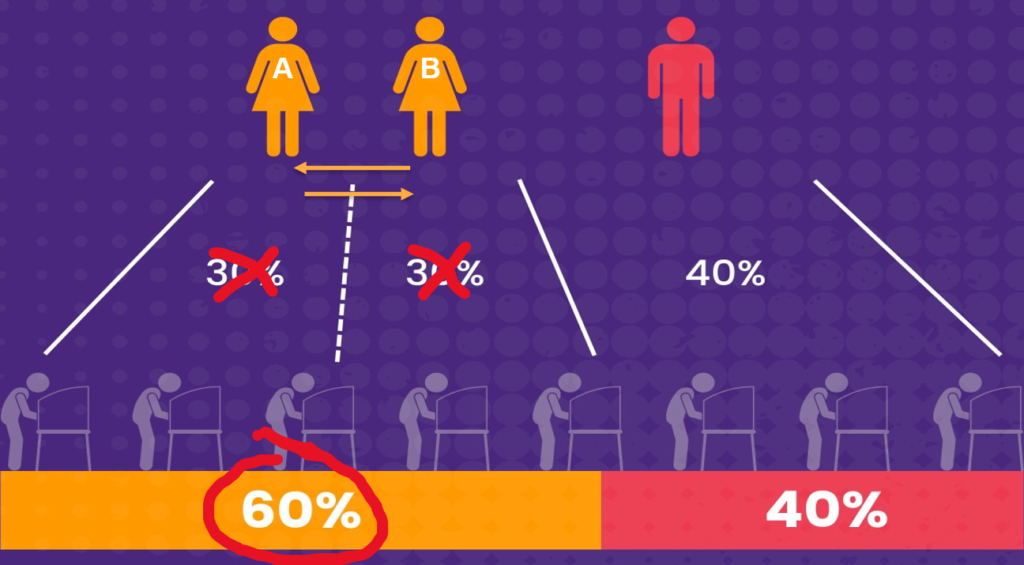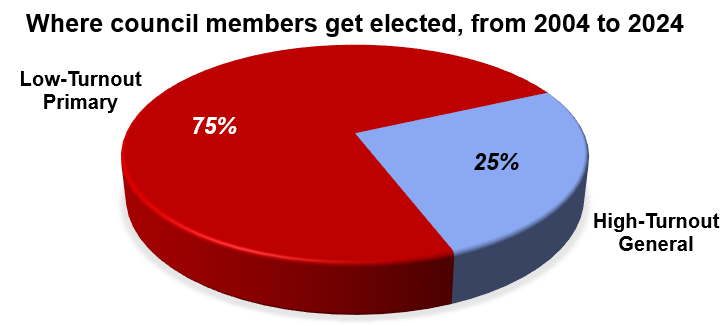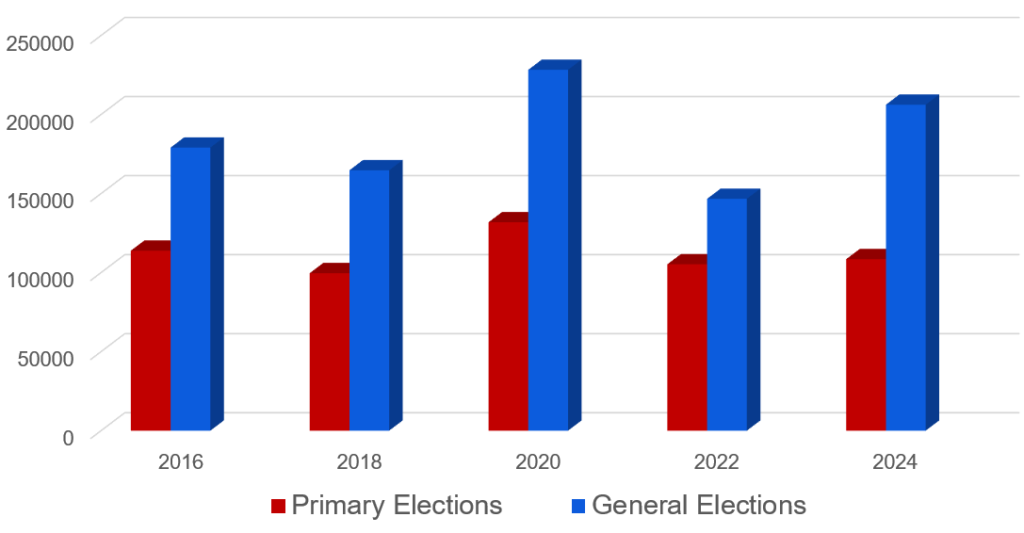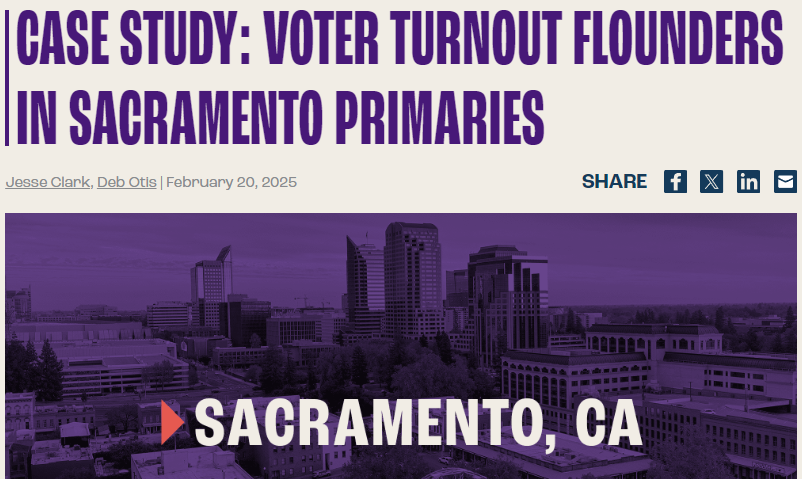RCV Improves Diversity
PROBLEM: Sacramento’s current system restricts voters’ choices and discourages some candidates from running for office. This could hurt diversity and representation on the campaign trail.
SOLUTION: RCV would give greater choice to the voters and open doors for more candidates to run for office, helping to elect candidates who earn the community’s support.
RCV REDUCES “VOTE-SPLITTING” AND IMPROVES VOTER CHOICE
In Sacramento’s current system, if two like-minded candidates from the same community run for office, they often risk “splitting the vote,” ruining their community’s chance of electing either one. This often happens to candidates from an underrepresented group.
Here’s an example. Looking at the image below, Candidate A should be likely to win, since Candidate A is championing values (colored Orange) that are shared by 60% of voters. But when Candidate B also enters the race, Candidate B diverts some of those votes away from Candidate A (“splitting the Orange vote”), because Candidate B champions similar values. This allows Candidate C, who is the majority’s least preferred candidate, to win.

Anticipating this “vote-splitting” defeat, Orange activists will beg Candidate B to drop out of the race, actively trying to restrict voter choice and blaming Candidate B for causing problems.
This is only logical if you want the Orange community to have any shot at winning.
And if you’re an Orange voter in this scenario, you’re forced to choose between two candidates you support equally, possibly hurting the only one who had a chance.
The color Orange in this example can easily represent any given community that is historically marginalized in traditional elections. Such communities are consistently told, by the plain mathematical logic of elections, that they can only run one candidate, or else they spoil their chances completely.
RCV fixes this problem. RCV allows you the voter to name one candidate as your first choice and another candidate as your backup. That way, if your first choice can’t win, your vote simply slides over to your backup candidate and counts just as meaningfully for them.
Either way, your vote counts. You don’t have to worry about throwing your vote away.
This not only improves your experience as a voter, it also allows multiple similar candidates to run without fear of splitting the vote.

Allowing more like-minded candidates to run, without paying a possible “vote-splitting” penalty, is another way RCV elections are fairer and more representative than Sacramento’s current system.
This may explain why RCV improves diversity and representation on the campaign trail, allowing like-minded candidates to run without fear of “splitting the vote.”
RCV WOULD ALSO SOLVE AN INEQUITY IN SACRAMENTO’S CURRENT SYSTEM
Sacramento’s current system uses a “two-round runoff” which usually elects a Council member in the Primary Election in the Spring. (By the time voters cast their ballots in the General Election in the Fall, the decision’s already been made and there are no local candidates on the ballot).

This is inherently unrepresentative because the Primary consistently gets extremely low voter turnout.
TOTAL BALLOTS CAST IN THE CITY OF SACRAMENTO: 2016 TO 2024

But even more concerning, the Primary’s voter turnout underrepresents younger voters and overrepresents older voters; and underrepresents renters and overrepresents homeowners.
In fact, the General Election’s turnout is a much more accurate reflection of the true community than the Primary’s turnout.
A recent study by research nonprofit FairVote finds the Primary Election turnout in the City of Sacramento deeply undermines voter representation.

RCV can solve this problem.
RCV would enable Sacramento to solve this inequity by moving all local races to the General Election, where more people vote and more diverse voices can be heard.
EVIDENCE SHOWS RCV IMPROVES DIVERSITY AND REPRESENTATION
Evidence from cities that use RCV shows RCV improves representation of women and people of color.
- Over the last decade, women in the U.S. have won 48% of all municipal RCV elections. As of 2020, nearly half of all mayors (46%) and city council seats (49%) decided by RCV are held by women. By comparison, women comprise only 23% of mayors in non-RCV jurisdictions. (See In Ranked Choice Elections, Women WIN, by RepresentWomen. 2020.)
- California cities that adopted RCV saw increases in the percentage of candidates of color running for office and in the probabilities of female candidates and female candidates of color winning office, according to a 2018 study. (See The alternative vote: Do changes in single-member voting systems affect descriptive representation of women and minorities?, by Sarah John, Haley Smith, and Elizabeth Zack. 2018.)
- People of color also hold office at a higher rate under RCV, according to a 2019 FairVote report on RCV in California cities. (See Ranked Choice Voting and Racial Minority Voting Rights, FairVote. 2019.)
- Candidates of color gain more votes in the round-by-round counting process than White candidates, indicating consensus-building, according to a 2021 FairVote study. Additionally, candidates of color in RCV elections pay no penalty when competing against other candidates of the same racial or ethnic group. (See Ranked choice voting elections benefit candidates and voters of color, FairVote. 2021.)
- RCV increases descriptive representation for women, people of color, and women of color, according to a 2016 FairVote report. This is because RCV is often used to replace unrepresentative, low-turnout elections and that it allows multiple candidates appealing to the same community to run without splitting the vote. (See Ranked Choice Voting and Representation of Underrepresented Groups, by Sarah John, Haley Smith, and Elizabeth Zack. 2016.)
- Research finds that RCV also opens doors for candidates from the LGBTQ+ community. For example:
- In 2021 – the first year New York City used RCV in its primaries – New Yorkers elected a record number of LGBTQ+ members to their city council. Among the new members was Crystal Hudson, the city’s first openly gay Black councilwoman.
- In 2021, Salt Lake City elected its first majority-LGBTQ city council in its first election using RCV. In 2023, the Salt Lake Tribune highlighted the council in its report on how Salt Lake City has become a bastion for the LGBTQ+ community in Utah.
- In 2017, Minneapolis elected Andrea Jenkins to the City Council with RCV – making her the first openly transgender Black woman elected to a public office in the United States. Jenkins was re-elected in 2021, and the City Council selected her as council president in 2022. In 2023, Jenkins was re-elected in a close, four-candidate contest; she did not win the most first-choice support, but consolidated support and won in RCV tabulation. In 2024, she supported an effort to bring ranked choice voting to elections in Washington, DC.
